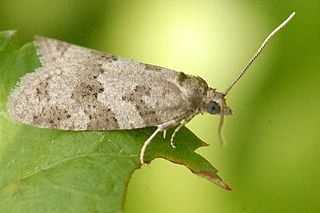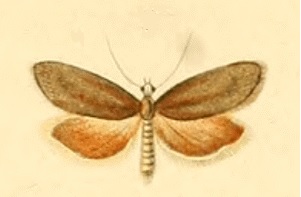
The Archipini are a tribe of tortrix moths. Since many genera of these are not yet assigned to tribes, the genus list presented here is provisional.

Cnephasia communana is a moth of the family Tortricidae. It is found in Europe.

Cnephasia stephensiana, the grey tortrix, is a moth of the family Tortricidae. It is found in the Palearctic realm, and has also been recorded from Canada.

Cnephasia asseclana, the flax tortrix, is a moth of the family Tortricidae. It is found all over Europe.

Cnephasia is a genus of tortrix moths. It belongs to the subfamily Tortricinae and therein to the tribe Cnephasiini, of which it is the type genus.

The Cnephasiini are a tribe of tortrix moths.

Depressaria daucella is a moth of the family Depressariidae. It is found in most of Europe, except most of the Balkan Peninsula. It is also found in North America.

Epermenia chaerophyllella, also known as the garden lance-wing, is a moth of the family Epermeniidae first described by Johann August Ephraim Goeze in 1783. It is found in all of Europe and Asia Minor.

Cnephasia gueneeana is a moth of the family Tortricidae. It was described by Philogène Auguste Joseph Duponchel in 1836. In Europe, it has been recorded from Great Britain, France, Italy and Greece. The species is native to the Mediterranean sub-region, ranging from Palestine and southern Europe to Morocco and the Canary Islands.

Cnephasia cupressivorana is a species of moth of the family Tortricidae. It is found on Corsica, Sardinia, Sicily and in Belgium, France, Spain, Italy, Switzerland, Austria, Croatia, Slovenia, Albania, Romania, North Macedonia, Greece, Asia Minor and Kyrgyzstan.

Cnephasia abrasana is a species of moth of the family Tortricidae. It is found in Europe, where it has been recorded from Albania, Bosnia and Herzegovina, Bulgaria, Romania, North Macedonia, Greece, Slovakia, Slovenia, Austria, Italy and Lithuania and on Corsica. It is also found in the Near East.
Cnephasia amseli is a species of moth of the family Tortricidae. It is found on Sicily and Malta and in North Africa, where it has been recorded from Tunisia.

Cnephasia chrysantheana is a species of moth of the family Tortricidae. It is found in the Near East, Spain, France, Italy, Austria, the Czech Republic, Slovakia, Slovenia, Hungary, Romania, Ukraine and on Sicily and Sardinia.

Cnephasia conspersana is a species of moth of the family Tortricidae. It is found in Ireland, Great Britain, France, Italy, Portugal, Spain and North Africa. The habitat consists of coastal chalk downlands and heathlands.
Cnephasia heringi is a species of moth of the family Tortricidae. It is found in Bulgaria, Greece, North Macedonia, Russia and Turkey.
Cnephasia delnoyana is a species of moth of the family Tortricidae. It is found in Portugal and Spain, where it has been recorded from Algarve and Almeria.
Cnephasia disforma is a species of moth of the family Tortricidae. It is found on Crete.

Phytomyza chaerophylli is a species of leaf mining fly in the family Agromyzidae which is found in Europe.

Sison amomum is one of several species of plant in the genus of Sison, its common name is stone parsley and it is native to Western and Southern Europe, North Africa and Turkey. The species and genus are flowering plants in the family Apiaceae, both of which were first described by Carl Linnaeus, in his book Species Plantarum, originally published in 1753. The plant has many synonyms, having also subsequently been described by other botanists, after Linnaeus, including Jean-Baptiste Lamarck, Richard Anthony Salisbury, Conrad Moench, Emanuel Mendes da Costa, and Albert Thellung among others.
















